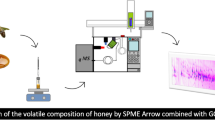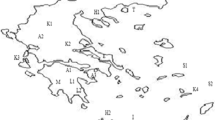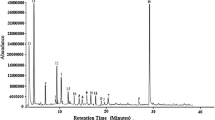Abstract
Solid phase microextraction (SPME) followed by comprehensive two-dimensional gas chromatography coupled to a time-of-flight mass spectrometer (GC×GC-TOF-MS) was used to characterise volatile organic compounds in honeys of different botanical origins. Rape, sunflower, acacia, lime, raspberry, and phacelia honeys from Slovakia were studied in detail. Up to 900 compounds were detected at the given S/N ratio of 200. The poorest VOC profiles were found for acacia and rape honeys while lime honey showed the richest VOC composition. Approximately 100 compounds were present in all honeys studied, independently of their botanical origin. They belong to various chemical classes (hydrocarbons, alcohols, aldehydes and ketones, terpenes, benzene derivatives, and compounds containing heteroatoms). The compounds found in only one type of honey were also successfully identified.
Similar content being viewed by others
References
Aronne, G., & De Micco, V. (2010). Traditional melissopalynology integrated by multivariate analysis and sampling methods to improve botanical and geographical characterisation of honeys. Plant Biosystems, 144, 833–840. DOI: 10.1080/11263504.2010.514125.
Baroni, M. V., Nores, M. L., Díaz, M. P., Chiabrando, G. A., Fassano, J. P., Costa, C., & Wunderlin, D. A. (2006). Determination of volatile organic compound patterns characteristic of five unifloral honey by solid-phase microextraction-gas chromatography-mass spectrometry coupled to chemometrics. Journal of Agricultural and Food Chemistry, 54, 7235–7241. DOI: 10.1021/jf061080e.
Blank, I., Fischer, K. H., & Grosch, W. (1989). Intensive neutral odourants of linden honey. Differences from honeys of other botanical origin. Zeitschrift für Lebensmitteluntersuchung und -Forschung A, 189, 426–433. DOI: 10.1007/bf01028316.
Čajka, T., Hajšlová, J., Cochran, J., Holadová, K., & Klimánková, E. (2007). Solid phase microextraction-comprehensive two-dimensional gas chromatography-time-of-flight mass spectrometry for the analysis of honey volatiles. Journal of Separation Science, 30, 534–546. DOI: 10.1002/jssc.200600413.
Castro-Vázquez, L., Díaz-Maroto, M. C., & Pérez-Coello, M. S. (2006). Volatile composition and contribution to the aroma of Spanish honeydew honeys. Identification of a new chemical marker. Journal of Agricultural and Food Chemistry, 54, 4809–4813. DOI: 10.1021/jf0604384.
Chudzinska, M., & Baralkiewicz, D. (2011). Application of ICPMS method of determination of 15 elements in honey with chemometric approach for the verification of their authenticity. Food and Chemical Toxicology, 49, 2741–2749. DOI: 10.1016/j.fct.2011.08.014.
Etzold, E., & Lichtenberg-Kraag, B. (2008). Determination of the botanical origin of honey by Fourier-transformed infrared spectroscopy: an approach for routine analysis. European Food Research and Technology, 227, 579–586. DOI: 10.1007/s00217-007-0759-9.
Guyot, C., Bouseta, A., Scheirma, V., & Collin, S. (1998). Floral origin markers of chesnut and lime tree honey. Journal of Agricultural and Food Chemistry, 46, 625–633. DOI: 10.1021/jf970510l.
Kaškonienė, V., Rimantas Venskutonis, P., & Čeksterytė, V. (2008). Composition of volatile compounds of honey of various floral origin and beebread collected in Lithuania. Food Chemistry, 111, 988–997. DOI: 10.1016/j.foodchem.2008.05.021.
Kenjerić, F. Č., Mannino, S., Bennedetti, S., Primorac, L., & Kenjerić, D. Č. (2009). Honey botanical origin determination by electronic nose. Journal of Apicultural Research, 48, 99–103. DOI: 0.3896/ibra.1.48.2.03.
Kukurová, K., Karovičová, J., Kohajdová, Z., & Bíliková, K. (2008). Authentication of honey by multivariate analysis of its physico-chemical parameters. Journal of Food and Nutrition Research, 47, 170–180.
Plutowska, B., Chmiel, T., Dymerski, T., & Wardencki, W. (2011). A headspace solid-phase microextraction method development and its application in the determination of volatiles in honeys by gas chromatography. Food Chemistry, 126, 1288–1298. DOI: 10.1016/j.foodchem.2010.11.079.
Radovic, B. S., Careri, M., Mangia, A., Musci, M., Gerboles, M., & Anklam, E. (2001). Contribution of dynamic headspace GC-MS analysis of aroma compounds to authenticity testing of honey. Food Chemistry, 72, 511–520. DOI: 10.1016/s0308-8146(00)00263-6.
Ruoff, K., Luginbühl, W., Bogdanov, S., Bosset, J. O., Estermann, B., Ziolko, T., & Amadò, R. (2006). Authentication of the botanical origin of honey by near-infrared spectroscopy. Journal of Agricultural and Food Chemistry, 54, 6867–6872. DOI: 10.1021/jf060770f.
Schievano, S., Capelli, C., Mayall Talylor, A., & Bonhoeffer, P. (2010). Application of computational simulations for percutaneous pulmonary valve implantation: (Percutaneous pulmonary valve computer analysis). Progress in Pediatric Cardiology, 30, 15–21. 10.1016/j.ppedcard.2010.09.003.
Soria, A. C., Martínez-Castro, I., & Sanz, J. (2003). Analysis of volatile composition of honey by solid phase microextraction and gas chromatography-mass spectrometry. Journal of Separation Science, 26, 793–801. DOI: 10.1002/jssc.200301368.
Stanimirova, I., Üstün, B., Cajka, T., Riddelova, K., Hajslova, J., Buydens, L. M. C., & Walczak, B. (2010). Tracing the geographical origin of honeys based on volatile compounds pro-files assessment using pattern recognition techniques. Food Chemistry, 118, 171–176. DOI: 10.1016/j.foodchem.2009.04.079.
Author information
Authors and Affiliations
Corresponding author
Rights and permissions
About this article
Cite this article
Špánik, I., Janáčová, A., Šusterová, Z. et al. Characterisation of VOC composition of Slovak monofloral honeys by GC×GC-TOF-MS. Chem. Pap. 67, 127–134 (2013). https://doi.org/10.2478/s11696-012-0254-z
Received:
Revised:
Accepted:
Published:
Issue Date:
DOI: https://doi.org/10.2478/s11696-012-0254-z




